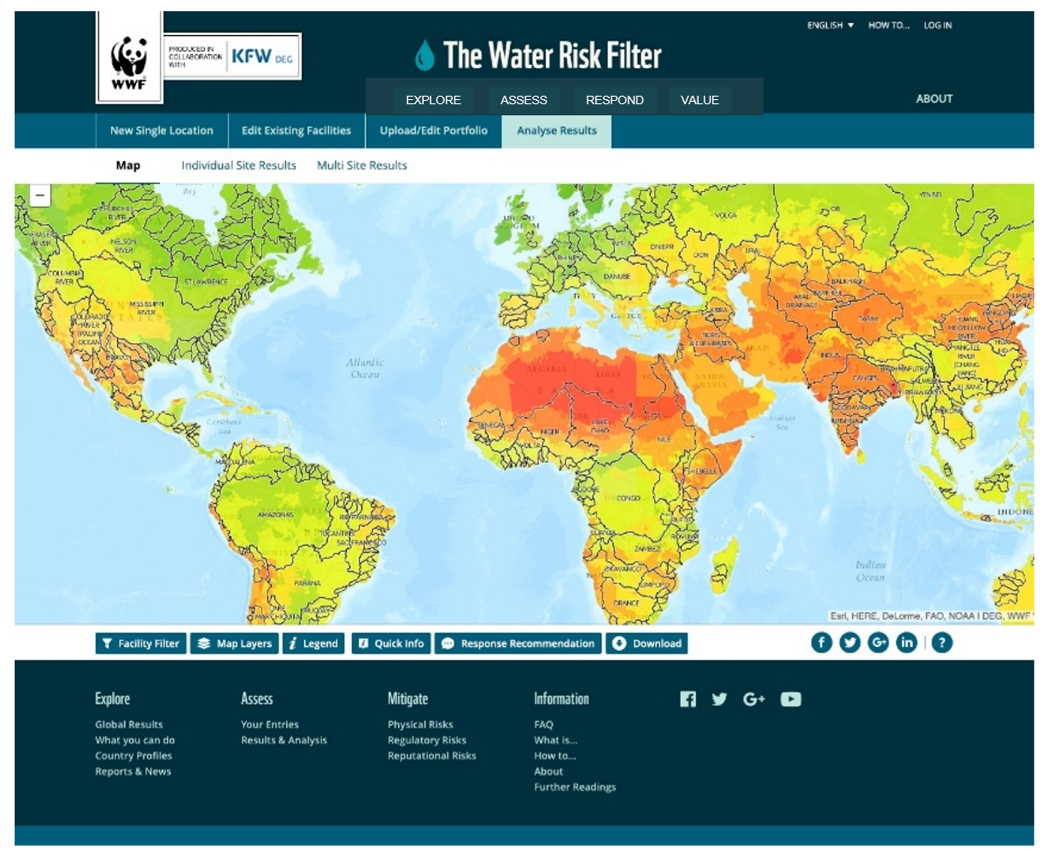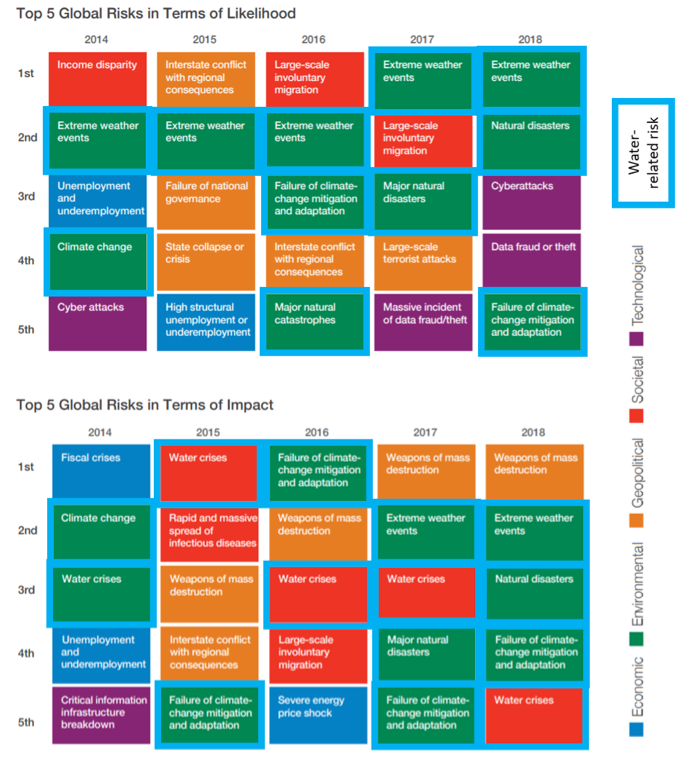How Many More Years Will It Be One of WEF’s Top Global Risks Before the World Starts Valuing Water?
Published on by Alexis Morgan, Water Stewardship Lead at WWF International in Business
Recently, the World Economic Forum (WEF) released its latest iteration of its annual Global Risk Report. Once again, water-related issues were top of mind both in terms of likelihood and severity, especially because — as we must continue to remind people — water (or the lack of water) is how the world is beginning to experience the impacts of climate change.
Granted, as water people, we have our bias when we look at the list, but four of the top five global risks in terms of impact over the next decade can be viewed as manifestations of water risk. “Extreme Weather Events”? Too much water (floods), or too little water (droughts). “Natural Disasters”? Flooding is #1 on that list. “Failure of climate change mitigation and adaptation”? The need to be better prepared to handle water challenges. “Water Crises”? Enough said.

What’s even more striking is the fact that water issues continue, year after year, to be top of mind. Over the past five years, water issues have shown up in directly in 44 percent (11/25) of the top risks by likelihood and indirectly in more than half (e.g., governance failures, human migration that’s often had a water-related driver). Similarly, in terms of impact the numbers are even higher with direct links to 56 percent of the top risks and nearly 70 percent by the time one accounts for food shortages/commodity price variability (often a function of droughts/floods) or the spread of infectious diseases (often driven by insects, which in turn are driven by water availability). Even more concerning is that the trend seems to be increasing. Water has increasingly shown up in the Global Risks report over the past decade and in the last few years has become even more prominent. For example, in both 2017 and 2018, 80% of the top risks in terms of impact have been water-related.
But the most striking fact of all is that despite water being the most prevalent and consistent aspect to the Global Risks report, water continues to be undervalued. The past two years have seen an effort by the High Level Panel on Water to raise the profile on the value of water. As WWF, we raised similar issues back in 2015 with our joint report with IFC. We also continue to flag the critical importance of the value of rivers for everything from economic growth and food security, to culture and the value of ecosystem services. River systems may indeed be the greatest global example of a market failure as both policies and markets have turned them into dumping grounds.
This shared failure to build robust green-grey infrastructure systems that support our rivers, wetlands and aquifers to sustainably provide sufficient water for people and nature cannot continue to be ignored. Basins that are facing stress translate into water risks for companies and investors — as we see through the WEF report. What is important, however, is that we develop context-specific solutions and deploy them at scale. The Water Risk Filter, which will be re-launched in 2018, is one tool that WWF harnesses to not only explore specific basin water risks, but then guide contextual response. It also offers the ability for investors to identify where there is a need for bankable projects that begin to systemically address this perennial water challenge. At WWF, we’re not only flagging the need to value our rivers, we’re scaling solutions by bringing financial capital to the table. From mutual funds to landscape finance projects, WWF is seeking to raise our level of ambition and solve the challenges.
We all need to work ensure that five years from now, when we read the latest WEF Global Risks report that water no longer represents 50 percent of the global risks. We must begin to harness capital markets to scale our response. Water is THE global risk facing our planet. It’s time we starting treating it that way.

Media
Taxonomy
- Water
- Water Risk Tools
- Economics
- Water Risk
- Climate Risk
- Economic development
4 Comments
-
Hello
Pls see hereafter what we do http://www.pranasustainablewater.ch/en/index.php to attract more investments in wastewater valorisation
-
Hello. Thank you.
What are your opinions on the following other ways to mitigate those risks:
- The stakeholders/states depleting/polluting water should be more liable for their actions for the next generations and pay heavy fines to be allocated for solving water issues. Why products not respecting the water exploitation index and other ecosystems requirements can often cheaper than responsible ones?
- Water can be recycled/reused infinitelly and some wastewater have a higher value than water because of the demand/prices of the wastewater by-products such as energy, fertilisers, bio-cements .... so should we put a higher value on water or pay a high price for products ending in wastewater but not easy to be recycled?
Thanks in advance for your answer,
1 Comment reply
-
To be fair a user pays scenario is necessary, the costs must be developed in parity to the resource carrying capacity. The value proposition from the water-energy-biotech nexus translates into a driver for the capture of the resources which decrease the costs associated with the treatment process. The water value should be relative to the carrying capacity of the source, less a value multiplier to encourage re-use. The value proposition also opens up the opportunity for more public-private partnerships and funding via project finance models. The added value of the elimination of the pollution is monetized by the alternative resource stream/s adding to the shift toward the desired outcome by the consumer in favor of the higher value from the more sustainable technology vs the higher cost typically required in the past. Before now it seemed to always cost more to be green. By utilizing utility integration and convergence in the planning and execution of the project the economic dynamic compared to comparable services delivered via the contemporary segregated utility functions is truly remarkable. These are the reasons for the Aquagen Infrastructure Systems, Inc. Sustainable Village Systems package design. Cheaper, Greener, Better, Saving the Planet with a higher standard of living for the community through a strong core circular economic dynamic.
-
-
The WEF, NACWA, EPA, "Utility of the Future" paradigm simply has to be embraced. Resource Reclamation has to be the top priority for our communities as a means of dealing with both the pressing need for new infrastructure in the developing world and the retrofit-rehabilitation of our existing antiquated inefficient technology in the developed world. If we do nothing but follow the same path, our future is not is doubt, we know that the quality of life in available water resources will be in serious decline in a relatively short period of time. We don't just need to deal with the water-energy-food infrastructure issue we need to deal with a lack of sustainable options in how we do things presently. This is a huge challenge, but if WEFTEC 2017 and industry publications globally is an indicator, change is afoot, and it is in the form of a transition from wastewater treatment to resource reclamation, smart communities and sustainability. I just hope the transition become main stream before the tipping point in non-renewable resource availability is reached.
1 Comment reply
-
We see circular economy as a concrete solution as follows : http://www.pranasustainablewater.ch/en/index.php
-
-
The current availability of fresh water for 7.5 billion people is 23,000 gallons per person per day for an average life span of 70 years. The proper use and cleaning of waste water is clearly the #1 item on the list. The current technology is able to clean black and grey water insitu with the only residue being potable drinking water and elements suspended yet not seen by naked eye. Mixing with kitchen organic matter you can grow a victory garden. By using a biogenerator you can collect loose electrons and use for electricity. If you have any concerns of growing deserts have no fear. Need only permission to transform deserts into farmland and then forests. Arabs are doing it without proper protocols. With an organized effort the Sahara, Gobi, or Australian deserts could be a forest in 5 years. The climate change scam is dead. We now have an opportunity to do real positive things for everyone on this planet not just the globalists.